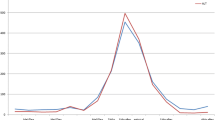Abstract
Hepatitis C virus reactivation (HCVr) was defined previously as an increase in HCV RNA level of ≥ 1 log10 IU/mL from baseline HCV RNA level after chemotherapies or immunosuppressive therapies, but HCVr during a steroid monotherapy has rarely been reported. Here we report a 75-year-old Japanese female with chronic hepatitis C (genotype 2a) who developed HCVr after the administration of prednisolone for interstitial pneumonia. She experienced alanine aminotransferase (ALT) flare with icterus, but after the tapering of prednisolone and a liver supporting therapy, levels of HCV RNA and ALT were gradually decreased. Then, she received an anti-viral therapy with sofosbuvir/ledipasvir. Although HCV relapsed 4 weeks after the therapy, a second therapy with glecaprevir/pibrentasvir was successful. This case suggests that HCVr with hepatitis flare can occur even after a steroid monotherapy, and we should pay attention to HCVr when we administer prednisolone for patients with HCV chronic infection.



Similar content being viewed by others
References
Suda G, Ogawa K, Morikawa K, et al. Treatment of hepatitis C in special populations. J Gastroenterol. 2018;53:591–605.
Lin M, Kramer J, White D, et al. Barriers to hepatitis C treatment in the era of direct-acting anti-viral agents. Aliment Pharmacol Ther. 2017;46:992–1000.
Mahale P, Kontoyiannis DP, Chemaly RF, et al. Acute exacerbation and reactivation of chronic hepatitis C virus infection in cancer patients. J Hepatol. 2012;57:1177–85.
Kusumoto S, Tanaka Y, Suzuki R, et al. Monitoring of hepatitis B virus (HBV) DNA and risk of HBV reactivation in B-cell lymphoma: a prospective observational study. Clin Infect Dis. 2015;61:719–29.
Manzano-Alonso ML, Castellano-Tortajada G. Reactivation of hepatitis B virus infection after cytotoxic chemotherapy or immunosuppressive therapy. World J Gastroenterol. 2011;17:1531–7.
Inoue J, Nakamura T, Masamune A. Roles of hepatitis B virus mutations in the viral reactivation after immunosuppression therapies. Viruses. 2019;11:457.
European Association for the Study of the Liver. EASL 2017 Clinical practice guidelines on the management of hepatitis B virus infection. J Hepatol. 2017;67:370–98.
Terrault NA, Lok ASF, McMahon BJ, et al. Update on prevention, diagnosis, and treatment of chronic hepatitis B: AASLD 2018 hepatitis B guidance. Hepatology. 2018;67:1560–99.
Lee HL, Bae SH, Jang B, et al. Reactivation of hepatitis C virus and its clinical outcomes in patients treated with systemic chemotherapy or immunosuppressive therapy. Gut Liver. 2017;11:870–7.
Torres HA, Hosry J, Mahale P, et al. Hepatitis C virus reactivation in patients receiving cancer treatment: a prospective observational study. Hepatology. 2018;67:36–47.
Mahale P, Thomas SK, Kyvernitakis A, et al. Management of multiple myeloma complicated by hepatitis C virus reactivation: the role of new antiviral therapy. Open Forum Infect Dis. 2016;3:ofv211.
Tagawa A, Ogawa T, Tetsuka S, et al. Hepatitis C virus (HCV) reactivation during fingolimod treatment for relapsing and remitting multiple sclerosis. Mult Scler Relat Disord. 2016;9:155–7.
Yazici O, Sendur MA, Aksoy S. Hepatitis C virus reactivation in cancer patients in the era of targeted therapies. World J Gastroenterol. 2014;20:6716–24.
Mori N, Imamura M, Takaki S, et al. Hepatitis C virus (HCV) reactivation caused by steroid therapy for dermatomyositis. Intern Med. 2014;53:2689–93.
Chen MH, Chen MH, Tsai CY, et al. Incidence and antiviral response of hepatitis C virus reactivation in lupus patients undergoing immunosuppressive therapy. Lupus. 2015;24:1029–36.
Ciesek S, Steinmann E, Iken M, et al. Glucocorticosteroids increase cell entry by hepatitis C virus. Gastroenterology. 2010;138:1875–84.
Magy N, Cribier B, Schmitt C, et al. Effects of corticosteroids on HCV infection. Int J Immunopharmacol. 1999;21:253–61.
Magrin S, Craxi A, Fabiano C, et al. Hepatitis C viremia in chronic liver disease: relationship to interferon-alpha or corticosteroid treatment. Hepatology. 1994;19:273–9.
Asahina Y, Itoh Y, Ueno Y, et al. Ledipasvir-sofosbuvir for treating Japanese patients with chronic hepatitis C virus genotype 2 infection. Liver Int. 2018;38:1552–61.
Asahina Y, Liu CJ, Gane E, et al. Twelve weeks of ledipasvir/sofosbuvir all-oral regimen for patients with chronic hepatitis C genotype 2 infection: integrated analysis of three clinical trials. Hepatol Res. 2020;50:1109–17.
Rumi MG, De Filippi F, La Vecchia C, et al. Hepatitis C reactivation in patients with chronic infection with genotypes 1b and 2c: a retrospective cohort study of 206 untreated patients. Gut. 2005;54:402–6.
Pitini V, Sturniolo G, Arrigo C, et al. HCV genotype 2 as a risk factor for reactivation in patients with B-cell lymphoma undergoing rituximab combination chemotherapy. Br J Haematol. 2010;150:116–8.
Kawano Y, Miyanishi K, Takahashi S, et al. Hepatitis C virus reactivation due to antiemetic steroid therapy during treatment of hepatocellular carcinoma. J Infect Chemother. 2017;23:323–5.
Brambilla S, Bellati G, Asti M, et al. Dynamics of hypervariable region 1 variation in hepatitis C virus infection and correlation with clinical and virological features of liver disease. Hepatology. 1998;27:1678–86.
Yuki N, Yoshioka A, Yasuda R, et al. Hepatitis C virus-associated neuropathy accompanied by eosinophilic vasculitis and granuloma formation. Intern Med. 2014;53:1187–90.
Author information
Authors and Affiliations
Corresponding author
Ethics declarations
Conflict of interest
JI received research grants from Gilead Sciences and AbbVie GK. The other authors state that they have no conflict of interest.
Human and animal rights
All procedures followed have been performed in accordance with the ethical standards laid down in the 1964 Declaration of Helsinki and its later amendments.
Informed consent
Written consent was obtained from the patient to publish the clinical and virological findings.
Additional information
Publisher's Note
Springer Nature remains neutral with regard to jurisdictional claims in published maps and institutional affiliations.
Rights and permissions
About this article
Cite this article
Sato, K., Inoue, J., Kakazu, E. et al. Reactivation of hepatitis C virus with severe hepatitis flare during steroid administration for interstitial pneumonia. Clin J Gastroenterol 14, 1221–1226 (2021). https://doi.org/10.1007/s12328-021-01432-4
Received:
Accepted:
Published:
Issue Date:
DOI: https://doi.org/10.1007/s12328-021-01432-4




